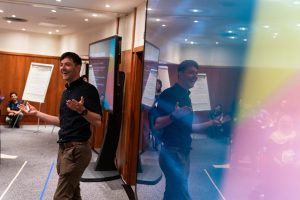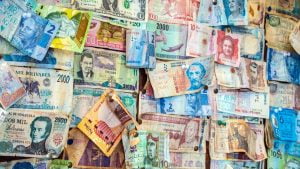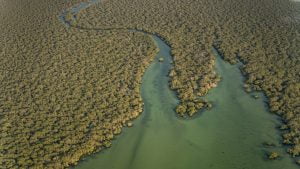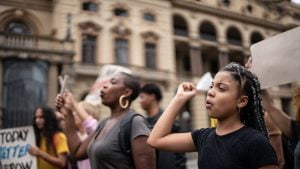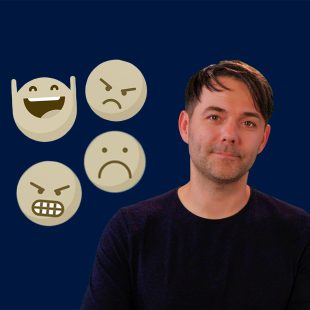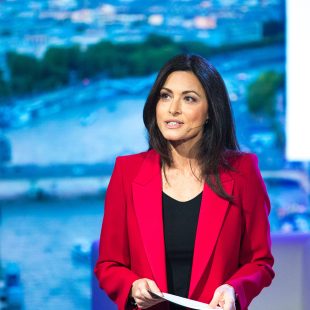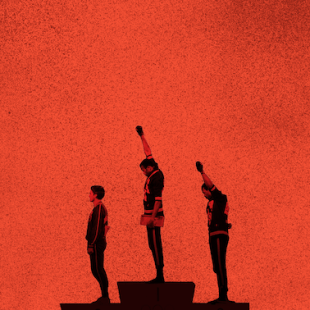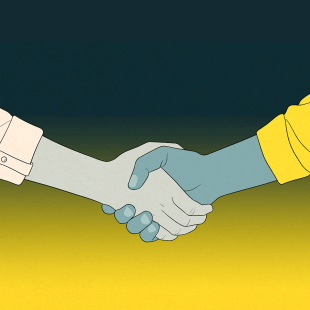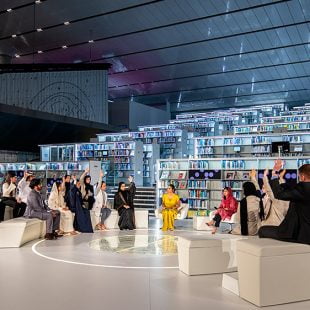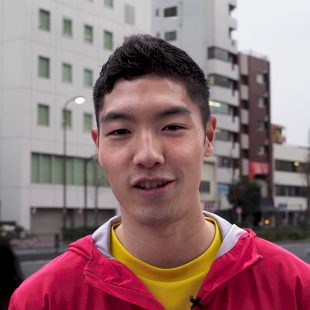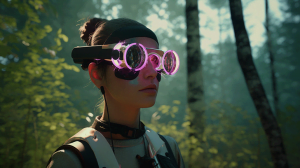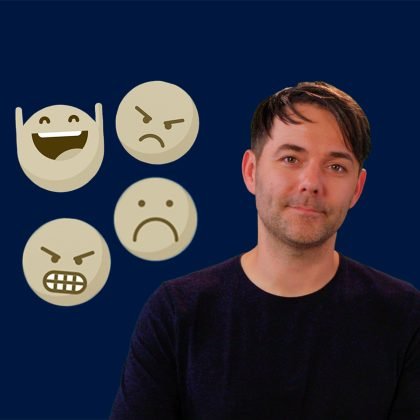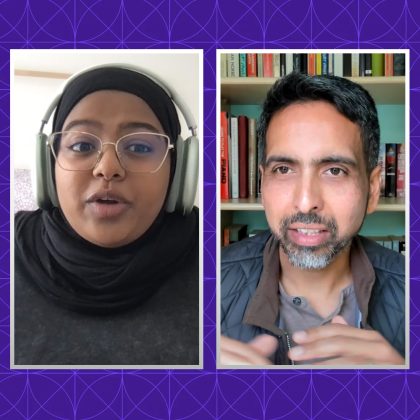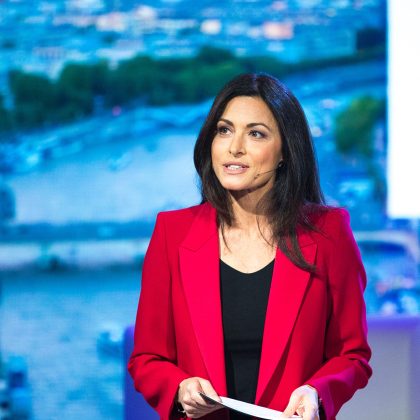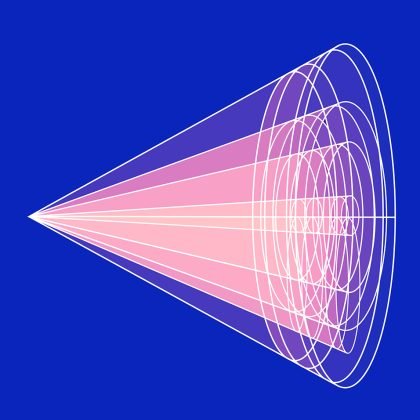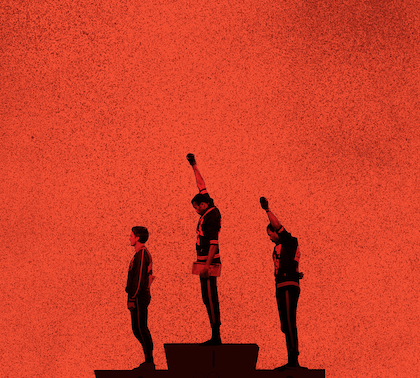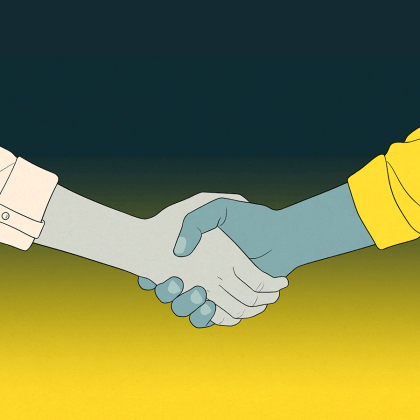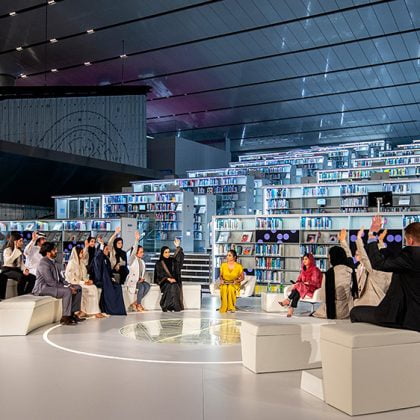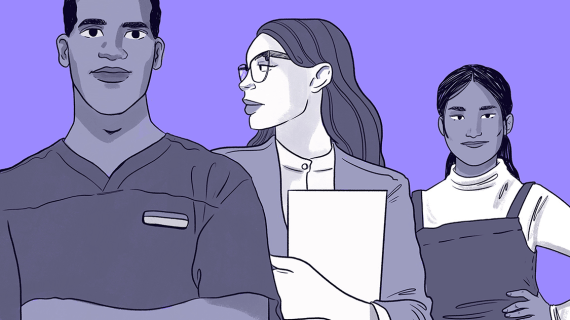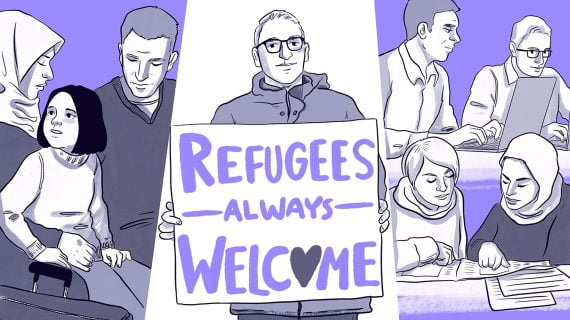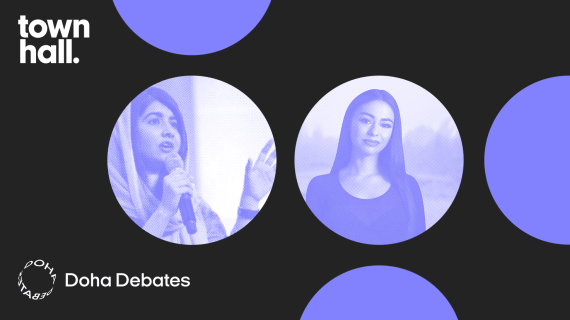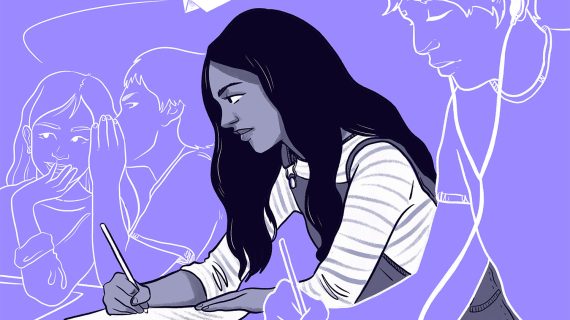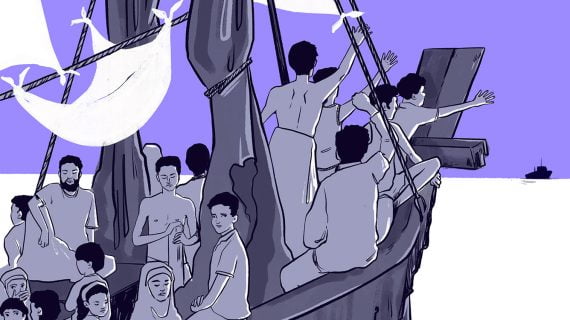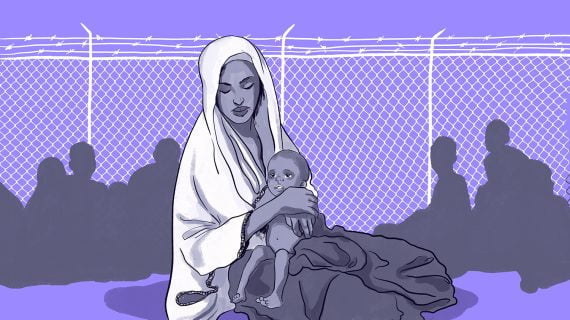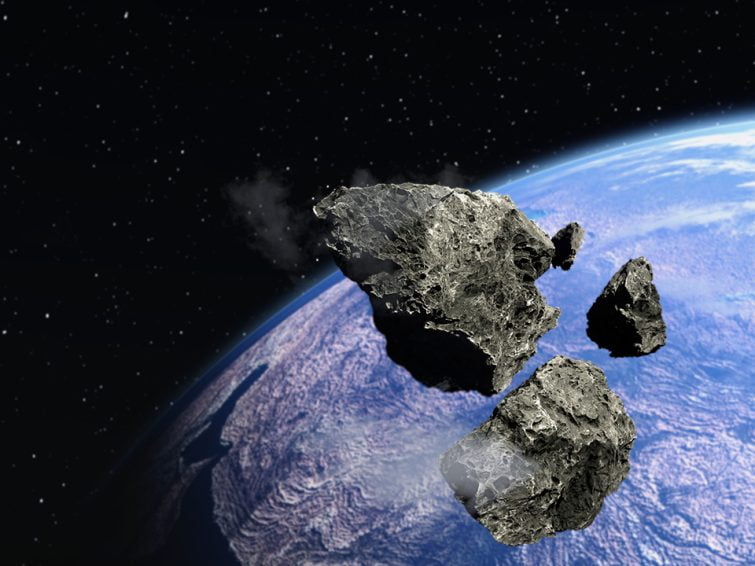Full transcript
Note: We encourage you to listen to the audio if you are able, as it includes emotion not captured by the transcript. Please check the corresponding audio before using any quotes.
[SYNTHESIZER MUSIC]
NELUFAR HEDAYAT, HOST:
This is “Course Correction” from Doha Debates. I’m Nelufar Hedayat. Each episode we’ll look at one big global problem… and meet the people who are actively working to fix it.
As nations around the world get richer, we’re all using more and more stuff. And the more stuff we buy, the more we end up throwing away.
The United States alone sends hundreds of millions of tons of trash into landfills each year. The garbage is piling up.
If we want to get out from under this trash heap, we need to use less, of course. But we also need to get better at recycling and upcycling — that’s turning old stuff into something different, new and useful. I don’t mean just taking old plastic bottles, and making new plastic bottles, or turning cardboard boxes into paper bags. We need to figure out how to stop throwing out the really tricky stuff. How to reuse complicated things like cars, mobile phones and computers. We need to learn how to break those down and make something new.
Veena Sahajwalla is an inventor, and the director of the Sustainable Materials Research and Technology department at the University of New South Wales. She figured out a way to use old rubber tires to make steel. No, really! And she invented tiny, modular factories so small they could fit into your spare bedroom. And they can turn trash into things like tiles and tabletops.
The world’s garbage problem is messy and complicated, but it’s always been Veena’s passion.
VEENA SAHAJWALLA:
It was, to me, a beautiful challenge that had a holistic impact on the engineering, the science, the environment, society. Here’s a problem worth solving, you know? Because the impact of what this could mean to our society is huge.
NELUFAR: Do you know what, Veena, I really — before we get started into the meat and bones of this discussion, I just wanted to learn a little bit about you. Because you were really involved with waste and recycling and understanding how we use resources from quite a young age.
VEENA: Yeah, it was a — you can sort of call me — I’m looking at my office — you can kind of call me a very optimistic hoarder. I love stuff. I don’t know, I just was fascinated by stuff that other people just kind of wouldn’t think twice about it and throw it away into rubbish or, or not care much. For me, all of that was quite exciting, to look at and to imagine how that product came to life.
NELUFAR: Yeah. Because you grew up in Mumbai.
VEENA: Mmmm, you know, you could just literally go into Mumbai, into a little corner store and just, you know, find the exact specific thing that you wanted. And I would just get amazed with how many things, as a city, we could provide for millions of people. But associated with that was the obvious question: Then what happens to all these products at the end of their lives? All the bottles and paper and packaging. There was that whole economy where there were so many people who — of course, collecting bottles and, products that, you know, we were discarding.
NELUFAR: I mean, the thing that most people ignore, Veena, is the thing that you noticed. And at such a young age — that’s quite remarkable. But you are also becoming more aware of the other side of that industry, you know, of what it meant to deal with what other people throw away. Like the toll it takes on people.
VEENA: Yeah. Look, absolutely. I think to me living in that highly disposable society in many instances was actually sometimes really heartbreaking. If a city’s becoming more and more wealthy, which of course, you know, places like Mumbai have become, it can actually sometimes have a negative impact because of course people then are expecting that disposable products are just part of life. Whereas it shouldn’t be that way. You know, piling up rubbish on streets and, and, we were doing that because sometimes we were ignoring the impact that waste has.
NELUFAR: What about the people who are responsible for collecting, sorting and reinventing that waste? What were their working and living conditions like? I mean, is the pay good? Are the working conditions beneficial? Are these people getting health insurance? I mean, what would the working conditions like be for somebody, say, who recycles circuit boards, or tries to extract other metals? I mean, can you paint me a picture?
VEENA: Yeah, for sure. No, look, I think life is really, really difficult because if you are someone who is working with dismantling circuit boards, you might actually be doing it with your bare hands. You might not even have proper tools, and you might be not protecting your feet, and you might not have proper safety gear to work with. But I think society owes it to people who work in this sector that we enable safe working conditions where people have protective gears and tools. And we should be asking: In this day and age, why are people still working under some of the most horrific conditions?
NELUFAR: Let’s get into, let’s get into the numbers. Let’s get into the science of it, then. If we take, for example, the issue of landfills. What are we doing with our waste when it comes to the landfills?
VEENA: One of the saddest things about — just thinking about landfills, is that it’s almost sort of then seen as this nice, easy solution. You know, whether we sort of think about burying our waste or burning our waste, it’s actually not doing justice to a lot of the useful materials. Because, let’s face it, it is really not the best solution, because there are so many valuable materials in there. So why are we seeing this end-of-life product that still may be extremely useful in the way we think about our materials for our everyday lives? I mean, let’s pick up something like waste tires. Just because a tire is no longer useful as a tire on a car — because the treads have worn out and it’s not safe to drive anymore — I mean, that rubber in that tire is still a useful material. Difficult to recycle in a traditional sense, but the fundamental molecules, whether it is about — you know, rubber, or plastic, in this case — we know that those molecules in these products are still there. They are still alive and kicking and we want to actually tap into those, you know, fundamental molecules. So we need to see recycling as beyond just the macro product of a piece of plastic or rubber tire. But rather, zoom in and use our imagination to channel, you know, figuratively what we could be looking into at the fundamental molecular level and going, “Wait a minute!” You don’t have to see it as just, “Oh gosh, I’ve got to recycle this glass back as glass again,” or “I’ve got to recycle this plastic back as plastic again.” You know, the macro product may be broken or fallen apart, but literally at the micro and the sub micro level, it is really possible to tap into these molecules and use them over and over again. And I think to me, there’s where the exciting bit is — that you can actually look at a combination of different types of, you know, materials. Like you could actually imagine waste glass that is rich in silica, combining with plastics, where you could get some carbon. And we’ve shown that from waste coming from cars — that you can actually create a ceramic material that is now a combination of the two. And that is silicon carbide.
NELUFAR: Wow.
VEENA: So suddenly, glass and plastics together — you know, can actually give you other possibilities. What if I could combine it and re-form it and create whole new reactions that allow me to create different types of, you know, materials. And in this case, silicon carbide is a really useful ceramic material.
NELUFAR: Yes. Now, speaking of upcycling and recycling, that’s like a major facet of your work currently. And you’ve — you sound so excited when you’re talking about the possibility and potential of waste as a resource and being able to create new solutions to these problems. Talk to me a little bit about the work that you’ve done when it comes to using waste to create and invent new things.
VEENA: Yeah, look, I mean — I think, yeah, being an inventor is, it’s kind of one of those things where it’s like a fever. Once you get it, you never let it go, because —
[LAUGHTER]
— it’s just something about being an inventor where, you know, all the thought bubbles, and million things racing inside your head — and you can kind of see the solution. You can see the pathway to the solution! You can just see how it’s going work — in your head, of course, it’s all doable!
[LAUGHTER]
But you know very well that as you start thinking about it more, as you start working on it, you end up having a conversation with yourself. And you can almost go, “Oh, I can do this!”
NELUFAR: Can you give me an example of when you’ve managed to do that?
VEENA: [LAUGHS] Yeah, no, look — I mean, even the current example of one of the technologies of green steel that we’ve commercialized with using —
NELUFAR: Green steel?
VEENA: Yes! So we’ve commercialized a technology whereby, you know, rubber has been used now as a result of our technology into the process of making steel where it’s injected into the furnaces.
NELUFAR: I’m sorry, hold on a second. You’re using rubber to make steel?
VEENA: [LAUGHS] Yes. It’s in the — it’s being used in the process of making steel. That’s right. Rubber tires!
NELUFAR: OK, you’re going to have to walk me through this one, Veena, really slowly.
VEENA: Yes, yes, yes. Think about what lies deep within the rubber — are basically the molecules that make up that product. And so the fact that you can access all these useful molecules and use that in the process of making steel meant that — again, in theory, of course it should work — in practice, how are we going to do it? So that was really where the inventing happens. So effectively, the technology of polymer injection that has now been developed as a result of the science that I did — it’s really about recognizing that if you can get the rubber tires to react inside a steel-making furnace at the conditions under which steel is being produced, that rubber tire actually does not even remain as a rubber tire anymore. It literally breaks down into these tiny molecules that contain carbon and hydrogen. And that then gets consumed as part of the chemical reactions inside the steel-making furnace.
NELUFAR: Is this industry-standard now? I mean, is this how our steel is being manufactured?
VEENA: In many steel-making companies who have taken on a license to our technology, yes, green steel is being produced. And I think again, this is about the fact that businesses who are forward-thinking in their approach, who want to be innovative are actually going to see this as an investment in the future. They’re going to see this as an opportunity to be really proactive and to be really smart and go, “You know what, if there’s a solution here that allows me to not only recycle and re-form my tires, but at the same time reduce my coal and coke consumption.” The fact that we’ve now replaced part of that coal with rubber that is being injected into these furnaces, the steel-making furnace — as long as we can show that it’s comparable in terms of its efficiency — we would have achieved a huge outcome. And what we ended up finding was not only was it comparable, in many instances it actually made the steel-making operations much more efficient!
NELUFAR: Wait, there must be some noxious or toxic or harmful chemicals that are emitted once you burn old tires. I mean, that’s never a good thing, right? So how did you deal with that problem?
VEENA: You know, what we are doing here is not burning at all, and therefore we don’t get any of those noxious things that you’re referring to. Because of course you get that if you just burn tires in open air. But inside this beautiful steel-making furnace, you’re actually —
NELUFAR: Wow.
VEENA: — doing something completely different. The materials, the manufacturing, the reactions and the holistic occurrence of all these various phenomena actually have to occur hand in hand. And those synergies allow us to then deliver something that was never before considered possible.
NELUFAR: What about waste that’s more complex? Let’s say for example, a milk carton or a coffee cup, which has not only got paper in it, but it’s wrapped in very difficult, pernickety plastics, and different grades of plastic. How has your company, your organization, how do you work to try and get those more complex waste products back into a usable form?
VEENA: Actually, a very, very good question. Because indeed, you know, this is why sometimes our products don’t present themselves with a nice, simple opportunity of just — my plastic bottles being converted into my plastic bottle again — because you may well have plastics combined with paper. So, you know, what do you do? Do you simply go, “Right, you know, I can’t get plastic out of it. I can’t get paper out of it. I can’t de-laminate it because the two layers are stuck together.” You sort of almost give up.
NELUFAR: Yeah.
VEENA: You can actually imagine that you could be creating — co-creating — where you might have both, you know, metals and you might have carbon coming from your plastic — that were previously, of course, stuck together. And if you only think about how am I going to pull it apart, then you’re never going to arrive at a solution. So you think about the conditions under which you design your manufacturing processes, so that you can get the outputs from both of those materials. You can actually imagine that co-products’ generation out of all of these materials that are present. And that can only be done if you can do it in small-scale microfactories so you can have that distributed solution.
NELUFAR: Could you just outline to me, Veena, what do you mean when you say a microfactory? And how can we make recycling, and this inventive approach to dealing with waste, future-proof?
VEENA: Well at the very core of it is that we are transforming our materials into different types of products. Like any other factory, you’ve got an input and you can create an output which actually has value in our society. So for example, if I’ve got plastics and I want to be able to do something useful with it — in our microfactory in the basement, we’ve got one module where we make plastic filaments. You can further add value to it by using it for 3D printing. And then you can start to print and manufacture objects. The point about a microfactory is that it’s affordable, it’s doable, it’s localized and it can also manufacture different types of products.
NELUFAR: And do you see these microfactories being in most offices and buildings and households in the future?
VEENA: I think it’s not so much about whether we put them in households, and I certainly wouldn’t, wouldn’t recommend that. It really is very much still about businesses operating microfactories — and yes, businesses and local councils and governments and communities can come together and collaborate and work together. So it is very much about collaboration and partnership —
NELUFAR: Right.
VEENA: — because nobody wants to see, you know, waste in our society.
NELUFAR: Who isn’t pulling their weight when it comes to the waste problem, Veena? Like — is it industry, is it corporations, governments? Who do you think is just not working hard enough or quick enough to solve this compounding problem?
VEENA: Yeah, look, I mean I think industries who make products and goods have to take responsibility to recognize that if they’re making profits out of selling off the goods, then they also have to recognize that some amount of that profit has to go towards doing something about the impact. But to simply take the easy option of saying, “Oh, well, I’ll just chuck it into landfill.” And I think this race to the bottom is the reason why a lot of businesses would just assume, “It’s cheaper, it’s easier. Why don’t I just throw it into landfill?”
NELUFAR: Veena, is the aim to hopefully one day just not have any new landfills on planet Earth?
VEENA: Yeah, I do hope that we get to that point where anybody who’s even thinking about putting away something into landfill is actually someone who the society looks at and goes, “What are you doing? There are better solutions out there!” So if we all start to have those voices within our communities and our friends and family and we inspire our local neighborhoods to start to think that way, everyone’s going to want to be a part of this exciting solution. And I think we all expect businesses and our governments to do the right thing.
NELUFAR: Now, I’m trying to understand psychologically, Veena, like — where are we going wrong with this? Why do we not put any value in our waste?
VEENA: I, I think as human beings sometimes we’ve been wired up to think really short-term, and as a society we’re sort of just focused on this immediate thing that we’re seeing in our hands. But rather if we sort of said, “’No, wait, OK, do I really need this? And what’s going to happen to it after, you know, a few days when I’m actually not using it anymore?” And just pause and take to think about the impact of every decision. If we remind ourselves that this has a long-term impact on the health of our planet then suddenly we’ll stop and go —
NELUFAR: Yeah.
VEENA: — “Oh wait, actually, you know what? No, maybe I don’t need this after all.”
NELUFAR: Dr. Veena Sahajwalla, thank you so much for talking to me today. I’ve, I’ve, I’ve been infected with your amazing ability to see the world differently. And I think you’re absolutely right: Like, we’ve got to change how we see things.
VEENA: Yeah, totally. Well thank you so much for having me on your show.
[PERCUSSIVE MUSIC]
NELUFAR: That’s all from the show today. Why not get onto our website, dohadebates.com, for our latest short films, live debates and more. And also, remember, I always want to hear from you. Tweet us at @DohaDebates.
[CREDITS]
“Course Correction” is written and hosted by me, Nelufar Hedayat. The show is produced by Doha Debates and Transmitter Media. Doha Debates is a production of Qatar Foundation. Special thanks to our team at Doha Debates — Japhet Weeks, Amjad Atallah and Jigar Mehta. And if you like what you hear, rate and review the show. It helps other people find us. Join us for the next episode of “Course Correction” wherever you get your podcasts.
Our other podcasts
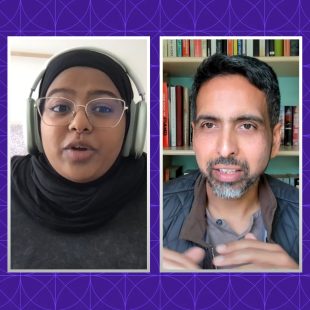
Doha Debates Podcast
Doha Debates Podcast brings together people with starkly different opinions for an in-depth, human conversation that tries to find common ground.

Lana
A podcast in Arabic for today’s generation to discuss their outlook on the world, hosted by Rawaa Augé.

Necessary Tomorrows
Mixing speculative fiction and documentary, leading sci-fi authors bring us three futures that seem like fantasy. We meet the writers who dream of these futures and the activists, scientists and thinkers who are turning fiction into fact.
